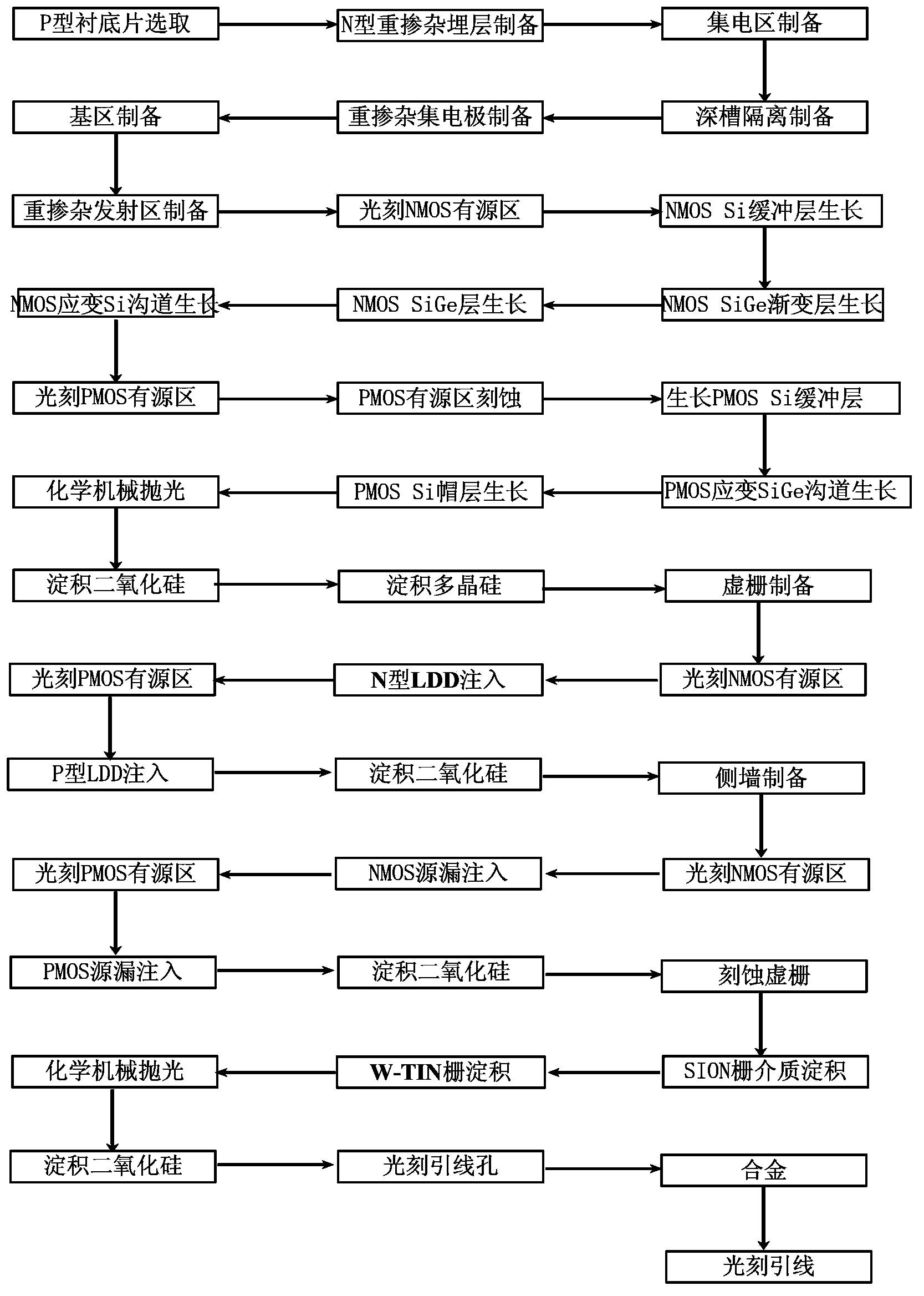Double-strain plane BiCMOS (Bipolar Complementary Metal-Oxide-Semiconductor Transistor) integrated device and preparation method
An integrated device, double-strain technology, applied in semiconductor/solid-state device manufacturing, electric solid-state devices, semiconductor devices, etc., can solve the problems of confinement, low carrier material mobility of Si materials, etc.
- Summary
- Abstract
- Description
- Claims
- Application Information
AI Technical Summary
Problems solved by technology
Method used
Image
Examples
Embodiment 1
[0096] Embodiment 1: preparation of a dual-strained plane BiCMOS integrated device and circuit with a conduction channel of 45nm,
[0097] Specific steps are as follows:
[0098] Step 1, epitaxial growth.
[0099] (1a) Select the doping concentration to be 5×10 14 cm -3 A P-type Si sheet as a substrate;
[0100] (1b) Thermally oxidize a layer of SiO with a thickness of 300nm on the substrate surface 2 layer;
[0101] (1c) Photoetching the buried layer region, implanting N-type impurities into the buried layer region, and annealing at 800° C. for 90 minutes to activate the impurities to form an N-type heavily doped buried layer region.
[0102] Step 2, isolation area preparation.
[0103] (2a) Remove the excess oxide layer on the surface, and epitaxially grow a layer with a doping concentration of 1×10 16 cm -3 The Si layer, with a thickness of 2 μm, serves as the collector area;
[0104] (2b) Thermally oxidize a layer of SiO with a thickness of 300nm on the substrate ...
Embodiment 2
[0147] Embodiment 2: Preparation of a dual-strained plane BiCMOS integrated device and circuit with a conductive channel of 30nm,
[0148] Specific steps are as follows:
[0149] Step 1, epitaxial growth.
[0150] (1a) Select the doping concentration as 1×10 15 cm -3 A P-type Si sheet as a substrate;
[0151] (1b) Thermally oxidize a layer of SiO with a thickness of 400nm on the substrate surface 2 layer;
[0152] (1c) Photoetching the buried layer region, implanting N-type impurities into the buried layer region, and annealing at 900° C. for 60 minutes to activate the impurities to form an N-type heavily doped buried layer region.
[0153] Step 2, isolation area preparation.
[0154] (2a) Remove the excess oxide layer on the surface, and epitaxially grow a layer with a doping concentration of 5×10 16 cm -3 A Si layer with a thickness of 2.5 μm acts as a collector area;
[0155] (2b) Thermally oxidize a layer of SiO with a thickness of 400nm on the surface of the subs...
Embodiment 3
[0198] Embodiment 3: preparation of a dual-strained plane BiCMOS integrated device and circuit with a conductive channel of 22nm,
[0199] Specific steps are as follows:
[0200] Step 1, epitaxial growth.
[0201] (1a) Select the doping concentration to be 5×10 15 cm -3 A P-type Si sheet as a substrate;
[0202] (1b) Thermally oxidize a layer of SiO with a thickness of 500nm on the surface of the substrate 2 layer;
[0203] (1c) Photoetching the buried layer region, implanting N-type impurities into the buried layer region, and annealing at 950° C. for 30 minutes to activate the impurities to form an N-type heavily doped buried layer region.
[0204] Step 2, isolation area preparation.
[0205] (2a) Remove the excess oxide layer on the surface, and epitaxially grow a layer with a doping concentration of 1×10 17 cm -3 The Si layer, with a thickness of 3 μm, serves as the collector area;
[0206] (2b) Thermally oxidize a layer of SiO with a thickness of 500nm on the sub...
PUM
 Login to View More
Login to View More Abstract
Description
Claims
Application Information
 Login to View More
Login to View More - Generate Ideas
- Intellectual Property
- Life Sciences
- Materials
- Tech Scout
- Unparalleled Data Quality
- Higher Quality Content
- 60% Fewer Hallucinations
Browse by: Latest US Patents, China's latest patents, Technical Efficacy Thesaurus, Application Domain, Technology Topic, Popular Technical Reports.
© 2025 PatSnap. All rights reserved.Legal|Privacy policy|Modern Slavery Act Transparency Statement|Sitemap|About US| Contact US: help@patsnap.com

